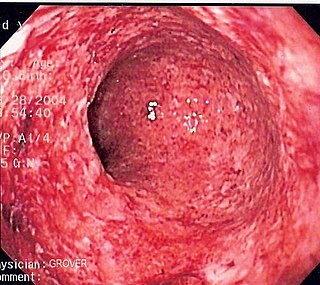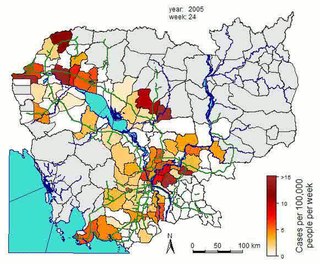
Crohn's disease is a chronic inflammatory bowel disease characterized by recurrent episodes of intestinal inflammation, primarily manifesting as diarrhea and abdominal pain. Unlike ulcerative colitis, inflammation can occur anywhere in the gastrointestinal tract, though it most frequently affects the ileum and colon, involving all layers of the intestinal wall. Symptoms may be non-specific and progress gradually, often delaying diagnosis. About one-third of patients have colonic disease, another third have ileocolic disease, and the remaining third have isolated ileal disease. Systemic symptoms such as chronic fatigue, weight loss, and low-grade fevers are common. Organs such as the skin and joints can also be affected. Complications can include bowel obstructions, fistulas, nutrition problems, and an increased risk of intestinal cancers.

Coeliac disease or celiac disease is a long-term autoimmune disorder, primarily affecting the small intestine, where individuals develop intolerance to gluten, present in foods such as wheat, rye and barley. Classic symptoms include gastrointestinal problems such as chronic diarrhoea, abdominal distention, malabsorption, loss of appetite, and among children failure to grow normally.

Lymphoma is a group of blood and lymph tumors that develop from lymphocytes. The name typically refers to just the cancerous versions rather than all such tumours. Signs and symptoms may include enlarged lymph nodes, fever, drenching sweats, unintended weight loss, itching, and constantly feeling tired. The enlarged lymph nodes are usually painless. The sweats are most common at night.

In epidemiology, incidence reflects the number of new cases of a given medical condition in a population within a specified period of time.

Kidney disease, or renal disease, technically referred to as nephropathy, is damage to or disease of a kidney. Nephritis is an inflammatory kidney disease and has several types according to the location of the inflammation. Inflammation can be diagnosed by blood tests. Nephrosis is non-inflammatory kidney disease. Nephritis and nephrosis can give rise to nephritic syndrome and nephrotic syndrome respectively. Kidney disease usually causes a loss of kidney function to some degree and can result in kidney failure, the complete loss of kidney function. Kidney failure is known as the end-stage of kidney disease, where dialysis or a kidney transplant is the only treatment option.
A medical condition is a broad term that includes all diseases and disorders.

The Legionellales are an order of Pseudomonadota ("Proteobacteria"). Like all Pseudomonadota, they are Gram-negative. They comprise two families, typified by Legionella and Coxiella, both of which include notable pathogens. For example, Q fever is caused by Coxiella burnetii and Legionella pneumophila causes Legionnaires' disease and Pontiac fever.
Venereology is a branch of medicine that is concerned with the study and treatment of sexually transmitted diseases (STDs). The name derives from Roman goddess Venus, associated with love, beauty and fertility. A physician specializing in venereology is called a venereologist. In many areas of the world, the specialty is usually combined with dermatology.
Phytophthora citricola is a plant pathogen. It was first described by Kaneyoshi (Kenkichi) Sawada in 1927 when it was isolated from orange trees in present-day Taiwan. It has since been found causing disease on a wide variety of plants.
Phoma tracheiphila is a fungal plant pathogen. It causes a disease known as Mal secco on citrus trees. It occurs in dry, cool climates such as the Mediterranean, Black Sea and Asia Minor. It forms pycniospores that are carried short distances by rain, or by wind to new leaves, where germinated hyphae invade stomata or more likely fresh wounds.

Alzheimer's disease (AD) is a neurodegenerative disease that usually starts slowly and progressively worsens. It is the cause of 60–70% of cases of dementia. The most common early symptom is difficulty in remembering recent events. As the disease advances, symptoms can include problems with language, disorientation, mood swings, loss of motivation, self-neglect, and behavioral issues. As a person's condition declines, they often withdraw from family and society. Gradually, bodily functions are lost, ultimately leading to death. Although the speed of progression can vary, the average life expectancy following diagnosis is three to twelve years.

An autoimmune disease is a condition that results from an anomalous response of the adaptive immune system, wherein it mistakenly targets and attacks healthy, functioning parts of the body as if they were foreign organisms. It is estimated that there are more than 80 recognized autoimmune diseases, with recent scientific evidence suggesting the existence of potentially more than 100 distinct conditions. Nearly any body part can be involved.

Parkinson's disease (PD), or simply Parkinson's, is a neurodegenerative disease primarily of the central nervous system, affecting both motor and non-motor systems. Symptoms typically develop gradually, with non-motor issues becoming more prevalent as the disease progresses. Common motor symptoms include tremors, bradykinesia, rigidity, and balance difficulties, collectively termed parkinsonism. In later stages, Parkinson's disease dementia, falls, and neuropsychiatric problems such as sleep abnormalities, psychosis, mood swings, or behavioral changes may arise.
Pyostomatitis vegetans is an inflammatory stomatitis and most often seen in association with inflammatory bowel disease, namely ulcerative colitis and Crohn's disease. Uncommonly, it may be one of the features of orofacial granulomatosis.

Pardoprunox (INN) is an antiparkinsonian drug developed by Solvay for the treatment of Parkinson's disease that reached phase III clinical trials before being discontinued. It was also being investigated for the treatment of depression and anxiety but these indications appear to have been abandoned as well.

Radequinil is a cognitive enhancer which acts as a partial inverse agonist of the benzodiazepine site of the GABAA receptor. It was under development by Dainippon Sumitomo Pharma for the treatment of Alzheimer's disease and made it to phase II clinical trials but development seems to have been halted and it was never marketed.

Umeclidinium bromide, sold under the brand name Incruse Ellipta, is a long-acting muscarinic antagonist approved for the maintenance treatment of chronic obstructive pulmonary disease (COPD). It is also approved for this indication in combination with vilanterol and also as a triple-therapy combination as fluticasone furoate/umeclidinium bromide/vilanterol.

Coronavirus disease 2019 (COVID-19) is a contagious disease caused by the coronavirus SARS-CoV-2. The disease spread worldwide, resulting in the COVID-19 pandemic.
Ghana Infectious Disease Centre (GIDC) is a centre built to improve the medical diagnostic and research capacity of Ghana with regard to infectious diseases. The facility was built due to the emergence of the COVID-19 pandemic in Ghana. Establishing the centre was facilitated by the Ghana COVID-19 Private Sector Fund in collaboration with the Ghana Armed Forces at the Ga East Municipal Hospital in Accra. The old Shai Osudoku District Hospital was also renovated into one of the infectious diseases centres in the Shai Osudoku District in Dodowa. This shares a boundary with the Shai Osudoku District Health Directorate. The president, Nana Addo Dankwa Akuffo Addo, inspected the centre on 30 October 2020












